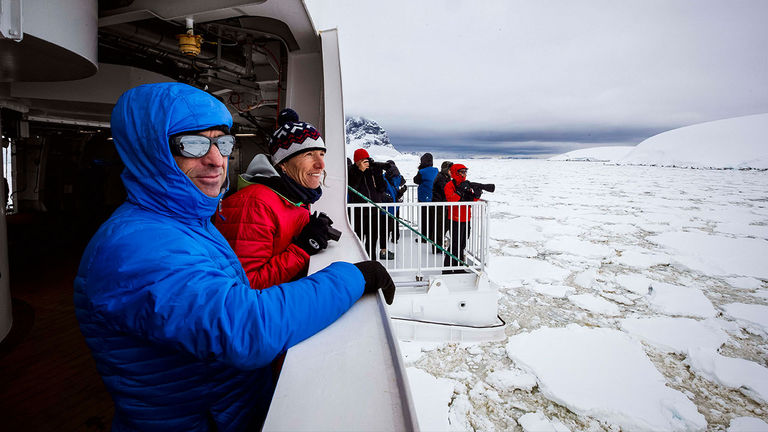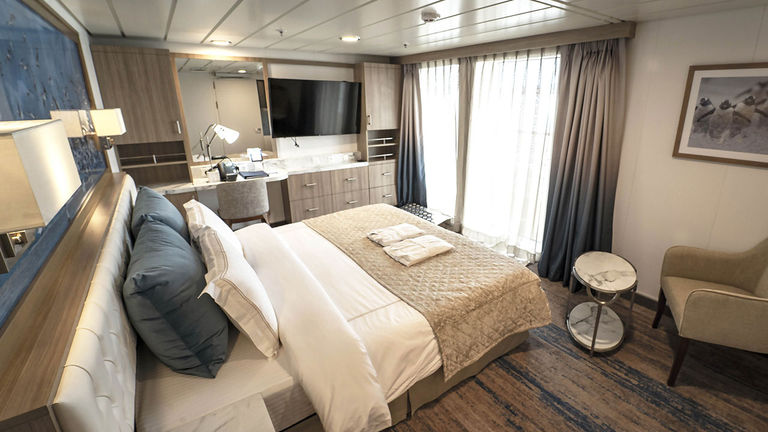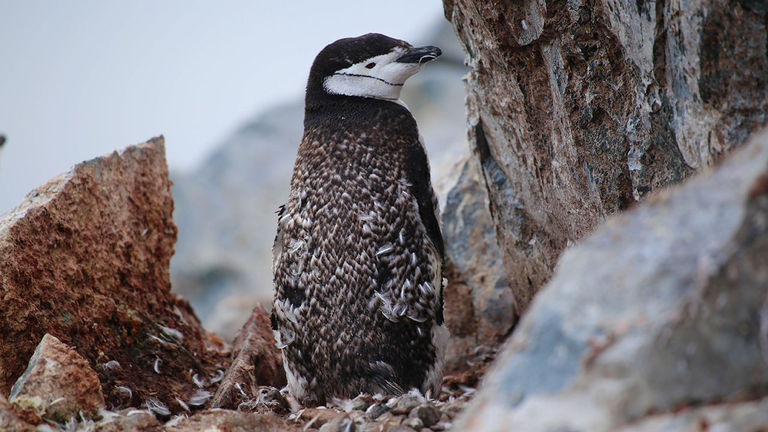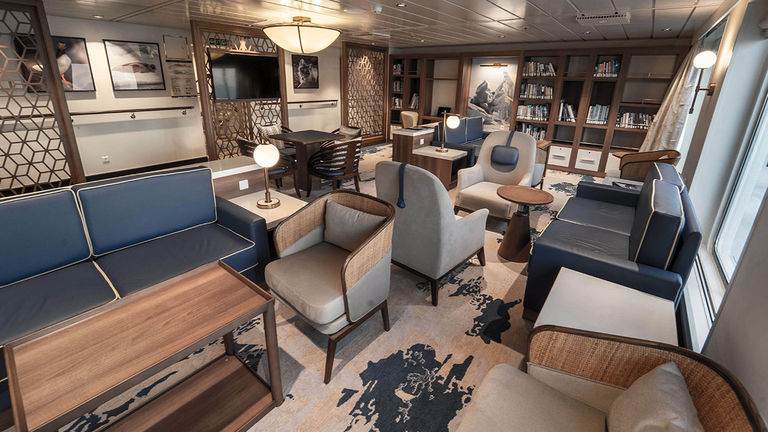The 2020-2021 winter season was supposed to be all about Antarctica.
Tourism to the region was growing, and the industry was enthusiastic about new expedition vessels purpose-built for the region. Of course, we know how that story ended — with closed borders and canceled cruises.
But one of the new ships that was lucky enough to enjoy a season of Antarctic travel before the March 2020 lockdowns was Aurora Expeditions’ Greg Mortimer, which launched in fall 2019.
It marked the first season that the Australian company had targeted North American cruisers, as well as a more premium clientele.
The ship’s namesake — Greg Mortimer — was the first Australian to summit Mount Everest, and he co-founded Aurora in 1991 to take adventurous clients climbing in Antarctica. That first iteration of the cruise line proudly revolved entirely around adventure, and not the ship: The Polar Pioneer was a basic, chartered vessel with shared bathroom facilities, and clients were involved in its operation.
Now the line is in its second act, with new leadership, new investors and an eye toward growth.
And while a dedicated kayaking program — as well as activities such as scuba diving, trekking and tent-less ice camping — should keep the most active clients busy throughout a sailing, guests who want to visit Antarctica in comfort (and with minimal exertion) will still be plenty stimulated and find the influence of expedition and adventure thoughtfully infused in their trip.
 Greg Mortimer’s Ulstein X-Bow allows the ship to cut through thick sea ice.
Greg Mortimer’s Ulstein X-Bow allows the ship to cut through thick sea ice.
Credit: 2021 Aurora ExpeditionsAmong the luxuries of the new vessel is the Ulstein X-Bow — an inverted hull reminiscent of a bird’s beak that helps the ship move more efficiently and smoothly through rough waters. The Mortimer is the first leisure ship to have this bow, though it certainly will not be the last.
Another draw are the 79 well-appointed guestrooms, which are in line with what you would find onboard a Viking ship — not showy or too artsy, but comfortable and well-considered.
My husband and I shared one of the entry-level rooms but were happy to find it was great for our needs, complete with a comfortable queen-size bed, ample lighting and charging stations. Beds face a large flat-screen television programmed with thematic films relevant to the sailing, such as a two-part series about Sir Ernest Shackleton’s expeditions in the region.
While our room came with a porthole, most categories feature balconies, which is worth the splurge if clients do not want to spring out of bed in the morning and sprint to the viewing deck the minute the expedition leader spots an orca.
 Guestrooms are smartly designed and include premium amenities including heated bathroom floors, flat-screen televisions and more.
Guestrooms are smartly designed and include premium amenities including heated bathroom floors, flat-screen televisions and more.
Credit: 2021 Aurora ExpeditionsOur bedroom also included an extra twin-size bed, which presents the possibility of fitting up to three guests in one room. Another premium amenity for a polar ship is the heated bathroom floor, which doubled as a convenient place to dry gloves and other items that got damp during excursions. But the heftiest wet gear — such as boots and life jackets, which are on loan for the duration of the cruise — can be stored in the mudroom, where each cabin is assigned its own locker.
The ship’s adventure staff takes pride in its activity preparation room, which has its own launching platform for unloading kayaks, meaning kayakers don’t have to wait for the ship’s 15 Zodiacs to depart, and often enjoy longer excursions.
The real focus on Aurora is to get clients out in the destination as many times as possible. Usually, guests can expect two landings per day thanks in part to the ship’s guest capacity, which is capped at 132 passengers. This selling point cannot be overstated; according to rules set by International Association of Antarctica Tour Operators, no more than 100 guests can land at one site at the same time, meaning clients on bigger vessels must take turns getting off the ship and, overall, spend far less time on excursions than those on smaller ships.
 Aurora Expeditions guests can choose to go on excursions with professional photographers who can help clients get the best shots.
Aurora Expeditions guests can choose to go on excursions with professional photographers who can help clients get the best shots.
Credit: 2021 Mindy PoderThe abundant time spent outside made onboard downtime that much sweeter. If I wasn’t learning about animals, expedition history and the next day’s offerings in the lecture room, I could usually be found on deck seven, home to the library, a large gym and the wellness center. A cozy corner of the ship, the library is flanked by two walls of books covering expeditions, science, animals and geological features related to the ship’s destinations.
Three floor-to-ceiling windows let in plenty of light, but I dozed off on multiple occasions. Even my best attempts to energize with the ship’s unlimited freshly baked cookies and well-rounded buffet meals were no match for the lulling effect of watching icebergs from a cozy corner of the library.
Another guest favorite is the sauna, the perfect supplement to a chilly excursion, or the polar plunge (though swimmers do receive a vodka shot post-jump).
 Downtime on the ship can be spent at the library, the gym, the spa, the sauna, the captain’s bridge and the lecture room.
Downtime on the ship can be spent at the library, the gym, the spa, the sauna, the captain’s bridge and the lecture room.
Credit: 2021 Aurora ExpeditionsAlso on deck seven is the captain’s bridge, which is open to guests for most of the cruise. The space is contained by an outdoor wraparound deck and connects to the eighth-floor panoramic viewing platform and lounge. One of the ship’s bars is here, ideal for those who brave the Antarctic breeze for a dip in one of two outdoor Jacuzzis.
And despite the cold, cruisers did regularly gather outside on the viewing decks and hydraulic platforms — especially when the ship encountered whales, penguins and breathtaking vistas.
Perhaps surprisingly, though, we were most excited when surrounded by thick ice. In mere seconds, the X-Bow would slice right through the hard surface, producing a satisfying crackle and two shards where there had been just one. It was both luxurious and totally thrilling at the same time.
Note: The line’s second purpose-built vessel, Sylvia Earle, will launch this year and is very similar to Greg Mortimer in its design and offerings. Early bookings for the 2022-2023 season are encouraged.
The Details
Aurora Expeditions
www.aurora-expeditions.com